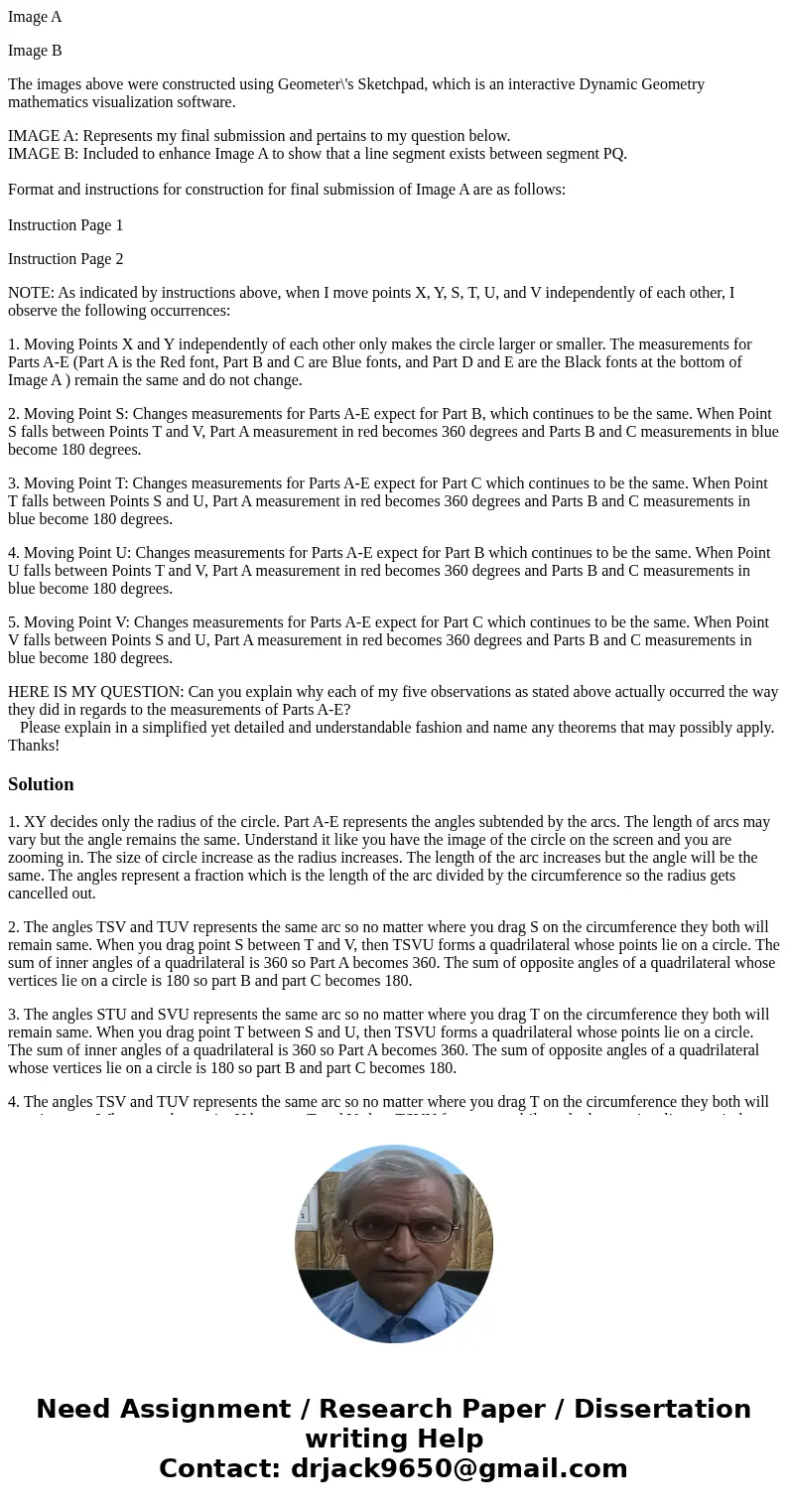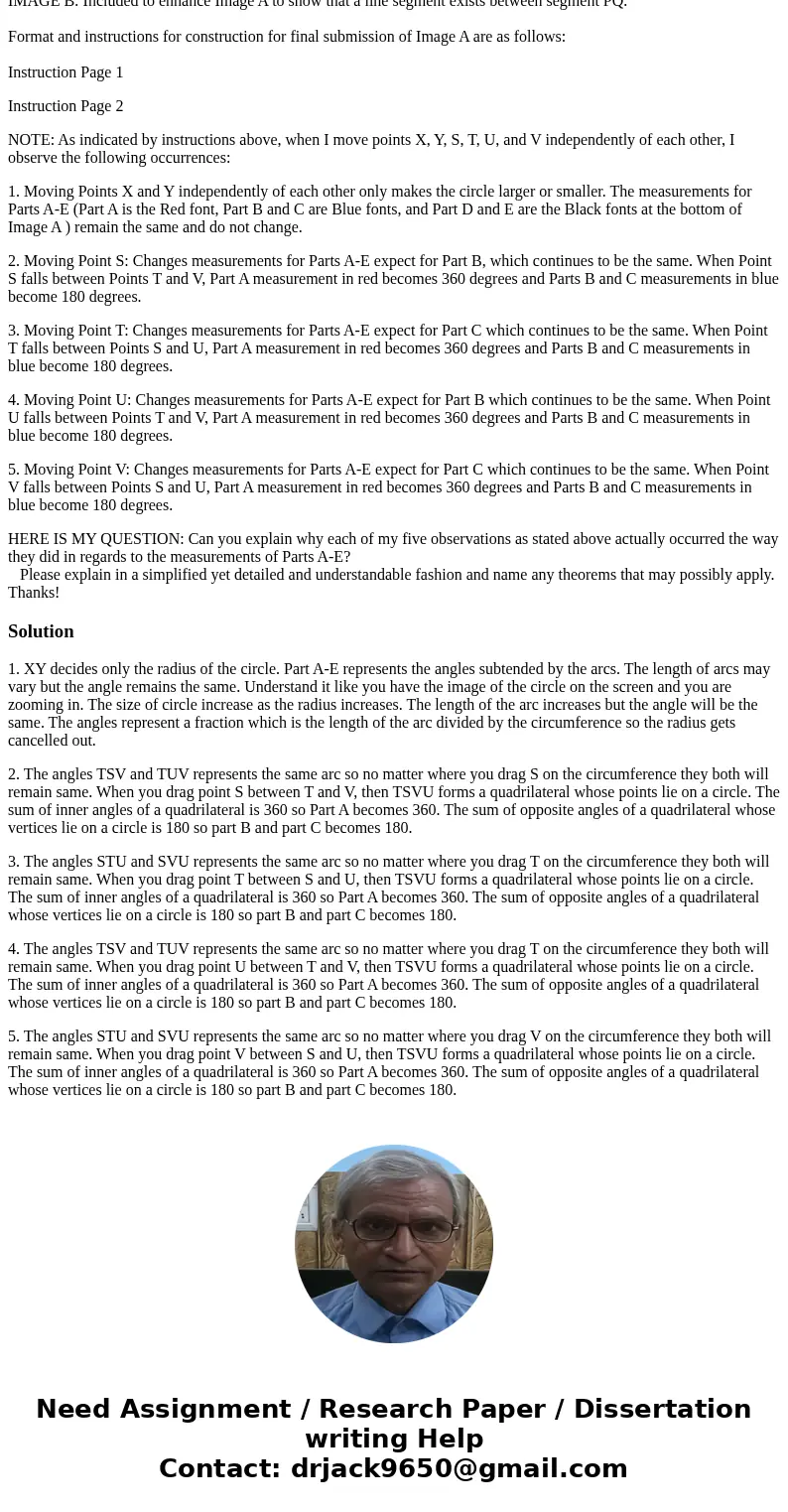Image A Image B The images above were constructed using Geom
Image A
Image B
The images above were constructed using Geometer\'s Sketchpad, which is an interactive Dynamic Geometry mathematics visualization software.
IMAGE A: Represents my final submission and pertains to my question below.
IMAGE B: Included to enhance Image A to show that a line segment exists between segment PQ.
Format and instructions for construction for final submission of Image A are as follows:
Instruction Page 1
Instruction Page 2
NOTE: As indicated by instructions above, when I move points X, Y, S, T, U, and V independently of each other, I observe the following occurrences:
1. Moving Points X and Y independently of each other only makes the circle larger or smaller. The measurements for Parts A-E (Part A is the Red font, Part B and C are Blue fonts, and Part D and E are the Black fonts at the bottom of Image A ) remain the same and do not change.
2. Moving Point S: Changes measurements for Parts A-E expect for Part B, which continues to be the same. When Point S falls between Points T and V, Part A measurement in red becomes 360 degrees and Parts B and C measurements in blue become 180 degrees.
3. Moving Point T: Changes measurements for Parts A-E expect for Part C which continues to be the same. When Point T falls between Points S and U, Part A measurement in red becomes 360 degrees and Parts B and C measurements in blue become 180 degrees.
4. Moving Point U: Changes measurements for Parts A-E expect for Part B which continues to be the same. When Point U falls between Points T and V, Part A measurement in red becomes 360 degrees and Parts B and C measurements in blue become 180 degrees.
5. Moving Point V: Changes measurements for Parts A-E expect for Part C which continues to be the same. When Point V falls between Points S and U, Part A measurement in red becomes 360 degrees and Parts B and C measurements in blue become 180 degrees.
HERE IS MY QUESTION: Can you explain why each of my five observations as stated above actually occurred the way they did in regards to the measurements of Parts A-E?
Please explain in a simplified yet detailed and understandable fashion and name any theorems that may possibly apply. Thanks!
Solution
1. XY decides only the radius of the circle. Part A-E represents the angles subtended by the arcs. The length of arcs may vary but the angle remains the same. Understand it like you have the image of the circle on the screen and you are zooming in. The size of circle increase as the radius increases. The length of the arc increases but the angle will be the same. The angles represent a fraction which is the length of the arc divided by the circumference so the radius gets cancelled out.
2. The angles TSV and TUV represents the same arc so no matter where you drag S on the circumference they both will remain same. When you drag point S between T and V, then TSVU forms a quadrilateral whose points lie on a circle. The sum of inner angles of a quadrilateral is 360 so Part A becomes 360. The sum of opposite angles of a quadrilateral whose vertices lie on a circle is 180 so part B and part C becomes 180.
3. The angles STU and SVU represents the same arc so no matter where you drag T on the circumference they both will remain same. When you drag point T between S and U, then TSVU forms a quadrilateral whose points lie on a circle. The sum of inner angles of a quadrilateral is 360 so Part A becomes 360. The sum of opposite angles of a quadrilateral whose vertices lie on a circle is 180 so part B and part C becomes 180.
4. The angles TSV and TUV represents the same arc so no matter where you drag T on the circumference they both will remain same. When you drag point U between T and V, then TSVU forms a quadrilateral whose points lie on a circle. The sum of inner angles of a quadrilateral is 360 so Part A becomes 360. The sum of opposite angles of a quadrilateral whose vertices lie on a circle is 180 so part B and part C becomes 180.
5. The angles STU and SVU represents the same arc so no matter where you drag V on the circumference they both will remain same. When you drag point V between S and U, then TSVU forms a quadrilateral whose points lie on a circle. The sum of inner angles of a quadrilateral is 360 so Part A becomes 360. The sum of opposite angles of a quadrilateral whose vertices lie on a circle is 180 so part B and part C becomes 180.


 Homework Sourse
Homework Sourse